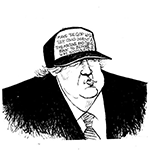Why Jaguar trashed everything you know for something new
Published in Automotive News
MIAMI BEACH — Art Basel opened on Friday, the penultimate event of Miami Art Week, when South Florida plays host to 20 international art fairs and more than 1,200 galleries, according to the show’s organizers.
But it’s the unveiling of Jaguar’s new design direction Monday night that continues to stir controversy, much like the overpriced pieces being hawked here. After all, this is the art fair where a banana duct-taped to a wall is called art. This is art all right, but not the kind you frame or collect.
Given this hothouse atmosphere, where the wealthy are willing to express their appreciation for — ahem — creativity and aren’t afraid to pay handsomely, the world’s luxury automakers are showcasing one-off vehicles and/or art installations. Lamborghini, BMW, Range Rover, Bentley, Lexus and Lotus are all present, hoping for a financial and emotional stake in the hearts and wallets of the well-to-do.
But no artwork, not even a duct-taped banana, has people talking as much as they are about Jaguar. Never mind the oddball video ad that debuted November 19, the one showing androgynous, disturbing human models rather than fetching automotive ones. Jaguar's two-seat battery electric concept cars revealed here, with 1,000 horsepower and 425 miles of battery-electric range, are a bold departure for the brand. And it has elicited ire from longtime fans, who don’t understand why the automaker would take such a drastic turn.
But it comes down to one reality: sales.
While fans can applaud the current design direction, the simple fact is that while they claim to love it, few vehicles were being sold. In 2003, Jaguar sold 54,655 cars in the United States according to Automotive News. Twenty years later, sales had shriveled 85 percent, to 8,284 units.
“We look back into our history, and what was very, very clear is when we were at our best, we were a brand that sold in relatively small volumes,” said Rawdon Glover, Jaguar's managing director. “We created desirable motor vehicles that connected at an emotional level with people. We were all about desirability.”
What Glover and others believe is that the company’s attempt to become a volume player in the luxury car space under Ford Motor Company ownership caused Jaguar to lose focus.
“What we are doing now is taking Jaguar back to its natural habitat for most of our 90-year history. That's where we play.”
So, dealers are selling down their 2,500-unit stockpile of current models, which include the F-Type sports car, XE and XF sedans, XF wagon, E-Pace SUV, and the I-Pace EV. Only the F-Pace SUV remains in production, as it shares much of its componentry with the Range Rover Velar.
But what’s next?
A battery-electric four-door GT, one that will be revealed in late 2025 before reaching showrooms six-to-nine months later. To give a taste of what that will entail, Jaguar unveiled the Type 00, or Type Zero Zero, which daringly walks away from its stylistic heritage. But it’s far from the first time. Company founder Sir William Lyons thought nothing of abandoning one design direction for another. The 1950 XK-120 looked nothing like the 1961 E-Type. The 1968 XJ6 sedan looks nothing like the Jaguar 420. The 1975 XJS reminded no one of an E-Type. It’s only in recent decades that the brand has become mired in regurgitating past design glories.
“Jaguar has its roots in originality. In the past, it was known for its visionary, unique esthetic and groundbreaking designs,” said Gerry McGovern, chief creative officer for Jaguar Land Rover.
For the Type 00, designers retained Jaguar’s iconic long hood/short cabin proportions, rather than shortening the hood, as in most new EVs. And rather than using an aerodynamic front end, the Type 00’s is fiercely vertical. The concept does retain a gracefully flowing roof line, as in past models. But it lacks a rear window, with pop-out rear-facing cameras supplying the rear view. Inside, you’ll find dual screens that fold down when not wanted, the essential information displayed at the base of the windshield. Uniquely, the cabin is trimmed with brass in an effort to embrace the car's history as it ages. And across the car, inside and out, Jaguar employs a field of parallel lines, which it calls the strikethrough. It’s a new brand hallmark, alongside its custom typeface and circular J and R logo.
It lends the Type 00’s a holistic design feel, something that’s remarkable given its design team is some 800 strong. While the car doesn’t photograph well, its design is striking and compelling. The team attempted to “copy nothing,” a design ethos laid down by the automaker’s founder. While some elements call to mind the Chrysler Crossfire and Nissan GT-R, overall, the design team succeeded in establishing a bold, fresh, youthful direction for the brand.
“It really goes back to this idea of how do you take that fearless creative spirit and reimagine it, transform it for a completely new audience, a new generation,” said Richard Stevens, Jaguar brand design director. “If you think about in our heyday, we never conformed, we never followed convention, but we never compromised on everything that we designed. And for us, it goes back to this context.”
©2024 Tribune Content Agency, LLC











Comments